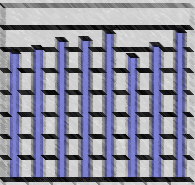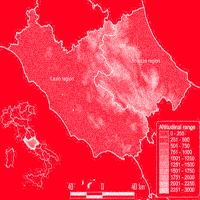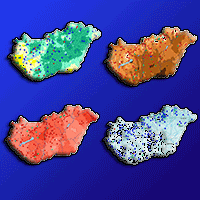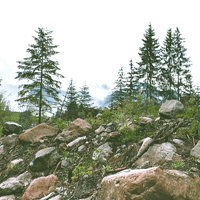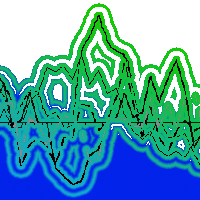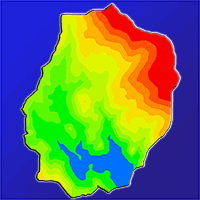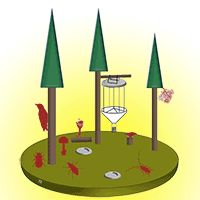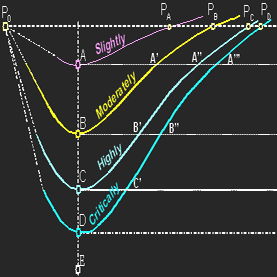The intensively monitored plots in Europe have offered a lot of information with regard to the dynamics of forest ecosystems. A large stock of data is already available as an input to ecological models. The carbon sequestration challenge is a little different from others. It requires long-term studies and additional information from what already exists. So far, apart from the determination of organic C in soils, research in the intensively monitored plots has mainly focused on above ground processes, i.e., crown assessment, phenology, deposition, litterfall, tree growth, and foliar chemistry. All these parameters are valuable and will continue to be so. However, according to the latest literature reviews on the subject, the key to understanding the reaction of trees to climate change lies in the dynamics of belowground processes. Information is needed on nitrogen mineralization rates, soil respiration rates and labile carbon forms in soils. If we take into account that countries pay for their carbon emissions and are paid for carbon sequestration, a research like this can be worth doing. Most importantly, the ecological models can be enriched and therefore be more precise in predicting tree response to climate change.
Keywords
, ,
Citation
Michopoulos P (2011). Effects of increasing CO2 on trees and intensively monitored plots: research needs in view of future ecosystem studies. iForest 4: 172-175. - doi: 10.3832/ifor0590-004
Paper history
Received: Nov 25, 2010
Accepted: Mar 09, 2011
First online: Aug 11, 2011
Publication Date: Aug 11, 2011
Publication Time: 5.17 months
© SISEF - The Italian Society of Silviculture and Forest Ecology 2011
Open Access
This article is distributed under the terms of the Creative Commons Attribution-Non Commercial 4.0 International (https://creativecommons.org/licenses/by-nc/4.0/), which permits unrestricted use, distribution, and reproduction in any medium, provided you give appropriate credit to the original author(s) and the source, provide a link to the Creative Commons license, and indicate if changes were made.

Breakdown by View Type
(Waiting for server response...)
Article Usage
Total Article Views: 52949
(from publication date up to now)
Breakdown by View Type
HTML Page Views: 45013
Abstract Page Views: 2749
PDF Downloads: 3758
Citation/Reference Downloads: 11
XML Downloads: 1418
Web Metrics
Days since publication: 5239
Overall contacts: 52949
Avg. contacts per week: 70.75
Article Citations
Article citations are based on data periodically collected from the Clarivate Web of Science web site
(last update: Mar 2025)
Total number of cites (since 2011): 2
Average cites per year: 0.13
Publication Metrics
by Dimensions ©
Articles citing this article
List of the papers citing this article based on CrossRef Cited-by.
(1)
Brown S (2002)Measuring carbon in forests: current status and future challenges. Environmental Pollution 116: 363-372.
CrossRef |
Gscholar
(2)
Cairns MA, Brown S, Helmer EH, Baumgardner GA (1997)Root biomass allocation in the world’s upland forests. Oecologia 111: 1-11.
CrossRef |
Gscholar
(3)
Chantigny MH (2003)Dissolved and water-extractable organic matter in soils: a review on the influence of land use and management practice. Geoderma 113: 357-380.
CrossRef |
Gscholar
(4)
Cheng WX, Johnson DW (1998)Elevated CO
2, rhizosphere processes, and soil organic matter decomposition. Plant and Soil 202: 167-174.
CrossRef |
Gscholar
(5)
Ceulemans R, Mouseau M (1994)Effects of elevated atmospheric CO
2 on woody plants. New Phytologist 127: 425-446.
CrossRef |
Gscholar
(6)
Ceulemans R, Janssens IA, Jach ME (1999)Effects of CO
2 enrichment on trees and forests: Lessons to be learned in view of future ecosystems studies. Annals of Botany 84: 577-590.
CrossRef |
Gscholar
(7)
Davidson EA, Belk E, Boone RD (1998)Soil water content and temperature as independent or confounded factors controlling soil respiration in a temperate mixed hardwood forest. Global Change Biology 4: 217-227.
CrossRef |
Gscholar
(8)
Davidson EA, Savage K, Bolstad P, Clark DA, Curtis PS, Ellsworth DS, Hanson PJ, Law BE, Luo Y, Pregitzer KS, Randolph JC, Zak D (2002)Belowground carbon allocation in forests estimated from litterfall and IRGA-based soil respiration measurements. Agricultural and Forest Meteorology 113: 39-51.
CrossRef |
Gscholar
(9)
De Lucia EH (1999)Net primary production of a forest ecosystem with experimental CO
2 enrichment. Science 284 (5417): 1177-1179.
CrossRef |
Gscholar
(10)
Dixon RK, Brown S, Houghton RA, Solomon AM, Trexler MC, Wisnieski J (1994)Carbon pools and flux of global forest ecosystems. Science 263: 185-190.
CrossRef |
Gscholar
(11)
Hanson PJ, Edwards NT, Garten CT, Andrews JA (2000)Separating root and soil microbial contributions to soil respiration: a review of methods and observations. Biogeochemistry 48: 115-146.
CrossRef |
Gscholar
(12)
Hättenschwiler S, Körner C (1996)System-level adjustment to elevated CO
2 in model spruce ecosystems. Global Change Biology 2: 377-387.
CrossRef |
Gscholar
(13)
Hättenschwiler S, Miglietta F, Raschi A, Körner C (1997)Morphological adjustment of mature Quercus ilex trees to elevated CO
2. Acta Oecologica 18: 361-365.
CrossRef |
Gscholar
(14)
Hendrick RL, Pregitzer KS (1993)The dynamics of fine root length, biomass and nitrogen content in two northern hardwood ecosystems. Canadian Journal of Forest Research 23: 2507-2520.
CrossRef |
Gscholar
(15)
Hungate BA, Dukes JS, Shaw MR, Luo Y, Field CB (2003)Atmospheric science: nitrogen and climate change. Science 302: 1512-1513.
CrossRef |
Gscholar
(16)
ICP-Forests (2010)ICP-Forests: International Co-operative Programme on Assessment and Monitoring of Air Pollution Effects on Forests.
Online |
Gscholar
(17)
IPCC (2001)Climate change: the scientific basis. Intergovernmental Panel on Climate Change. Cambridge University Press, Cambridge, UK.
Gscholar
(18)
Jiang PK, Xu QF (2006)Abundance and dynamics of soil labile carbon pools under different types of forest vegetation. Pedosphere 16: 505-511.
CrossRef |
Gscholar
(19)
Karnosky DF (2003)Impacts of elevated CO
2 on forest trees and forest ecosystems: knowledge gaps. Environment International 29: 161-169.
CrossRef |
Gscholar
(20)
Kimmins JP (1996)Forest ecology. A foundation for sustainable management. Prentice Hall, New Jersey, USA.
Gscholar
(21)
Kittredge JM, Rimmer JH, Looney MA (1994)Validation of the rockport fitness walking test for adults with mental retardation. Med Sci Sports Exerc 26 (1): 95-102.
Online |
Gscholar
(22)
Körner C (2000)Biosphere responses to CO
2 enrichment. Ecological Applications 10: 1590-1619.
CrossRef |
Gscholar
(23)
Lal R (2005)Forest soils and carbon sequestration. Forest Ecology and Management 220: 242-258.
CrossRef |
Gscholar
(24)
Lindroth RL, Kinney KK, Platz CL (1993)Responses of deciduous trees to elevated atmospheric CO
2: productivity, phytochemistry and insect performance. Ecology 74: 763-777.
CrossRef |
Gscholar
(25)
Luo Y, Reynolds J, Wang YP, Wolfe D (1999)Research for predictive understanding of plant responses to elevated CO
2. Global Change Biology 5: 143-156.
CrossRef |
Gscholar
(26)
Medlyn BE, Barton CMV, Broadmeadow MSI, Ceulemans R, De Angelis P, Forestreuter M, et al. (2001)Stomatal conductance of forest species after long-term exposure to elevated CO
2 concentrations: a synthesis. New Phytologist 149: 247-264.
CrossRef |
Gscholar
(27)
Melillo JM, McGuire DA, Kicklighter DW, Moore B, Vorosmarty CJ, Schloss AL (1993)Global climate change and terrestrial net primary production. Nature 363: 234-240.
CrossRef |
Gscholar
(28)
Michopoulos P, Economou A, Karetsos G, Tsagari K, Voulala M, Bourletsikas A, Kaoukis, K (2010)Nitrogen in a fir stand. Is there any risk of saturation? 13
th Greek Soil Science Congress, pp. 389-397. [In Greek with an english abstract].
Gscholar
(29)
Newman GS, Arthur MA, Muller RN (2006)Above and below ground net primary production in a temperate mixed deciduous forest. Ecosystems 9: 317-329.
CrossRef |
Gscholar
(30)
Norby RJ, Wullschleger SD, Gunderson CA, Johnson DW, Ceulemans R (1999)Tree responses to rising CO
2 in field experiments: implications for the future forest. Plant Cell Environment 22: 683-714.
CrossRef |
Gscholar
(31)
Norby RJ, Cotrufo MF, Ineson P, O’Neil EG, Canadell JG (2001)Elevated CO
2, litter chemistry, and decomposition: a synthesis. Oecologia 127: 153-165.
CrossRef |
Gscholar
(32)
Raich JW (1998)Aboveground productivity and soil respiration in three Hawaiian rain forests. Forest Ecology and Management 107: 309-318.
CrossRef |
Gscholar
(33)
Raich JW, Nadelhoffer KJ (1989)Belowground carbon allocation in forest ecosystems: global trends. Ecology 70: 1346-1354.
CrossRef |
Gscholar
(34)
Saxe H, Ellsworth DS, Heath J (1998)Tree and forest functioning in an enriched CO
2 atmosphere. New Phytologist 139: 395-436.
CrossRef |
Gscholar
(35)
Vincent G, Shahriari AR, Lucot E, Badot PM, Epron D (2006)Spatial and seasonal variations in soil respiration in a temperate deciduous forest with fluctuating water table. Soil Biology and Biochemistry 38: 2527-2535.
CrossRef |
Gscholar
(36)
Weiss NA (1989)Elementary statistics. Addison-Wesley Publishing Company, Massachusetts, USA.
Gscholar
(37)
Zhao M, Zhou J, Kalbitz K (2008)Carbon mineralization and properties of water-extractable organic carbon in soils of the south Loess Plateau in China. European Journal of Soil Biology 44: 158-165.
CrossRef |
Gscholar
